本章解释了参考作物蒸发腾发量(ETo)和标准条件下的作物蒸发腾发量(ETc)以及各种管理和环境条件(ETc adj)的概念以及两者之间的差异。它还研究了影响蒸发腾发量的因素、蒸发腾发量的正常表达单位以及确定蒸发腾发量的方式。
EVAPOTRANSPIRATION PROCESS 蒸发腾发过程
水分一方面通过蒸发从土壤表面流失,另一方面通过蒸腾从作物中流失的两个独立过程的组合称为蒸散量(ET)。
译者注:ET 在农业水利行业也叫蒸发腾发量。在气象等专业叫作蒸散量。实际上都是从英文单词: Evapotranspiration 译来, 以下无必要说明的,两者可能会混用。
Evaporation 蒸发
蒸发是将液态水转化为水蒸汽(蒸发)并从蒸发表面上散去(蒸汽去除)的过程。水从各种表面蒸发,如湖泊、河流、路面、土壤和潮湿植被表面。
将水分子的状态从液体变为蒸汽需要能量。直接的太阳辐射,以及在一定程度上的空气环境温度,提供了这种能量。从蒸发表面去除水蒸气的驱动力是蒸发表面的水蒸气压力与周围大气的水蒸气压力之差。随着蒸发的进行,周围的空气逐渐饱和,过程将减慢,如果湿空气还没有转移到大气中,过程可能会停止。用干燥空气替换饱和空气在很大程度上取决于风速。因此,在评估蒸发过程时,太阳辐射、空气温度、空气湿度和风速都是要考虑的气候参数。
如果蒸发面是土壤表面,作物冠层的遮荫程度和蒸发面上的可用水量是影响蒸发过程的其它因素。频繁的降雨、灌溉和从浅水位向上输送的水湿润了土壤表面。如果土壤能够以足够快的速度供水以满足蒸发需求,那么土壤的蒸发量仅由气象条件决定。然而,如果降雨和灌溉之间的间隔变大,土壤将水分传导到土壤表面的能力变小,表层土壤中的水分含量就会下降,土壤表面就会变干。在这种情况下,有限的土壤内的水分对土壤蒸发有控制作用。在土壤没有任何水分来源的情况下表面蒸发迅速减少,几天内几乎会完全停止。
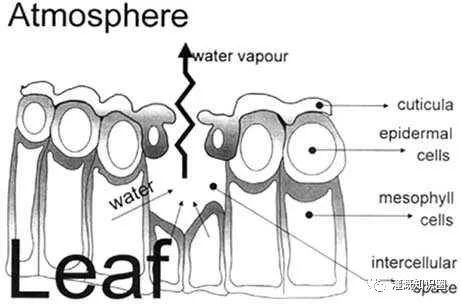
FIGURE 1. Schematic representation of a stoma 图1. 气孔的示意图
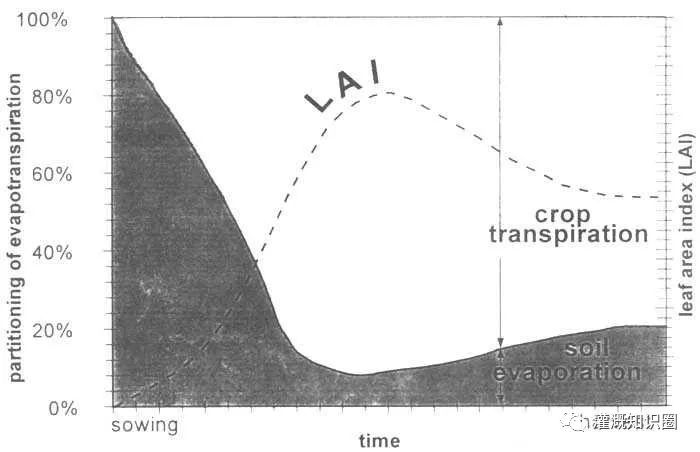
FIGURE 2. The partitioning of evapotranspiration into evaporation and transpiration over the growing period for an annual field crop 图2. 对一年生大田作物而言,在生长期间将蒸散分为蒸发和蒸腾
Transpiration 蒸腾
蒸腾作用包括植物组织中所含液态水的蒸发和蒸汽进入大气。作物主要通过气孔失水。这些是植物叶片上的小气孔,气体和水蒸气通过这些气孔开口散失的(图1)。水分和一些营养物质被根系吸收并通过植物茎叶运输。蒸发发生在叶片内部,即细胞间空隙间,与大气的蒸汽交换由气孔孔径开口控制。几乎所有被吸收的水分都会因蒸腾作用而流失,只有一小部分被用于植物器官内部。
蒸腾作用与直接蒸发一样,取决于能量供应、蒸气压梯度和风。因此,在评估蒸腾作用时,应考虑辐射、空气温度、空气湿度和风项。土壤含水量和土壤将水分传导至根系的能力也决定了蒸腾速率,同样也决定了淹水和土壤水分的盐分。蒸腾速率还受作物特性、环境因素和栽培方式的影响。不同种类的植物可能有不同的蒸腾速率。在评估蒸腾作用时,不仅要考虑作物类型,还要考虑作物发育期、环境和管理。
Evapotranspiration (ET) 蒸散量(ET)
蒸发和蒸腾同时发生,没有简单的方法来区分这两个过程。除了表层土壤中的水分可利用性外,种植土壤的蒸发主要取决于到达土壤表面的太阳辐射的比例。随着作物的生长和作物冠层遮住越来越多的土地面积,这一比例在生长期间会减少。当作物较小时,水分主要通过土壤蒸发流失,但一旦作物发育良好并完全覆盖土壤,蒸腾作用就成为主要过程。在图2中,蒸发蒸腾分为蒸发和蒸腾,其对应于其下方是每单位土壤表面的叶面积。在播种时,近100%的ET来自蒸发,而在全作物覆盖时,超过90%的ET来自蒸腾。
Units 单位
蒸散量通常以单位时间的毫米(mm)表示。该速率以水深为单位表示单位面积的表面损失的水量。时间单位可以是一小时、一天、十年、一个月,甚至是整个生长期或一年。
由于一公顷的地表面积为10000 m^2,1 mm等于0.001 m,因此每公顷损失1 mm的水相当于损失10 m^3的水。换句话说,1毫米1天相当于10立方米1公顷1天。
水深也可以用单位面积接收的能量来表示。能量是指蒸发自由水所需的能量或热量。这种被称为汽化潜热(l)的能量是水温的函数。例如,在20°C时,l 约为2.45 MJ kg-1。换句话说,蒸发1千克或0.001立方米的水需要2.45兆焦耳。因此,每平方米2.45 MJ的能量输入能够蒸发0.001 m或1 mm的水,因此1 mm的水相当于2.45 MJ m-2。以MJ m-2 day-1为单位表示的蒸散率用l ET表示,即潜热通量。
表1总结了用于表示蒸散率和转换系数的单位。
TABLE 1. Conversion factors for evapotranspiration 表1. 蒸散量换算系数
depth | volume per unit area | energy per unit area * | ||
mm day-1 | m3 ha-1 day-1 | l s-1 ha-1 | MJ m-2 day-1 | |
1 mm day-1 | 1 | 10 | 0.116 | 2.45 |
1 m3 ha-1 day-1 | 0.1 | 1 | 0.012 | 0.245 |
1 l s-1 ha-1 | 8.640 | 86.40 | 1 | 21.17 |
1 MJ m-2 day-1 | 0.408 | 4.082 | 0.047 | 1 |
* For water with a density of 1000 kg m-3 and at 20°C. 对于密度为1000 kg m-3且温度为20°C的水。
EXAMPLE 1. Converting evaporation from one unit to another 例1. 将蒸发量单位之间的转换
On a summer day, net solar energy received at a lake reaches 15 MJ per square metre per day. If 80% of the energy is used to vaporize water, how large could the depth of evaporation be? | |||
From Table 1: | 1 MJ m-2 day-1 = | 0.408 | mm day-1 |
Therefore: | 0.8 x 15 MJ m-2 day-1 = 0.8 x 15 x 0.408 mm d-1 = | 4.9 | mm day-1 |
The evaporation rate could be 4.9 mm/day | |||
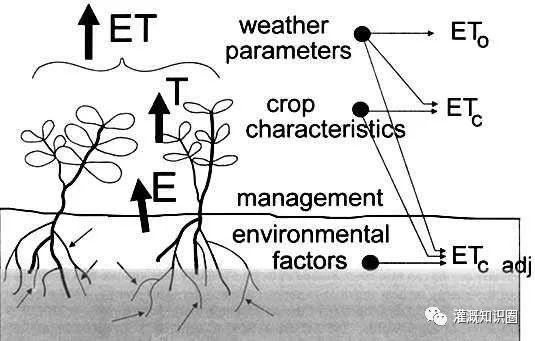
FIGURE 3. Factors affecting evapotranspiration with reference to related ET concepts 图3 影响蒸散量的相关因素
Factors affecting evapotranspiration 影响蒸散的因素
天气参数、作物特性、管理和环境方面是影响蒸发和蒸腾的因素。图 3 中介绍的相关 ET 概念,在前面的蒸发蒸腾概念部分进行了论述。
Weather parameters 天气参数
影响蒸散的主要天气参数是辐射、气温、湿度和风速。已经开发了几种程序来评估这些参数的蒸发速率。大气的蒸发能力由参考作物蒸发量(ETo)表示。参考作物蒸散量代表标准化植被表面的蒸散量。本章稍后以及第 2 章和第 4 章将详细描述 ETo。
Crop factors 作物因素
在评估在管理良好的大田中种植的作物的蒸散量时,应考虑作物类型、品种和发育阶段。蒸腾阻力、作物高度、作物粗糙度、反射、地被和作物生根特性的差异导致相同环境条件下不同类型作物的ET水平不同。标准条件下的作物蒸散量(ETc)是指在适宜的土壤水分、优良的管理和环境条件下大面积种植的作物,并在给定的气候条件下实现充分生产的作物的蒸发需求。
Management and environmental conditions 管理和环境条件
土壤盐分、土地肥力差、有限的化肥施用、土壤坚硬或难以穿透、缺乏病虫害控制和土壤管理不善等因素可能会限制作物生长并减少蒸散。评估 ET 时要考虑的其它因素是地被、植物密度和土壤含水量。土壤含水量对 ET 的影响主要取决于水分亏缺程度和土壤类型。另一方面,过多的水会导致涝渍,这可能会损害根系并通过抑制呼吸作用限制根系对水分的吸收。
在评估 ET 率时,应额外考虑对影响 ET 过程的气候和作物因素起作用的管理实践范围。耕作方式和灌溉方法的类型会改变小气候,影响作物特性或影响土壤和作物表面的润湿。防风林会降低风速并降低直接超出屏障的场的 ET 率。尽管树木本身的蒸散量可能会抵消田间的任何减少,但这种影响尤其在有风、温暖和干燥的条件下尤为显著。通过使用精心设计的滴灌或滴灌系统,可以减少树木间距较大的年轻果园的土壤蒸发。滴头直接向树木附近的土壤浇水,从而使大部分土壤表面保持干燥,并限制蒸发损失。使用覆盖物,特别是在作物较小的情况下,是另一种显著减少土壤蒸发的方法。抗蒸腾剂,如气孔关闭、加膜或反射材料,可减少作物的水分损失,从而降低蒸腾速率。
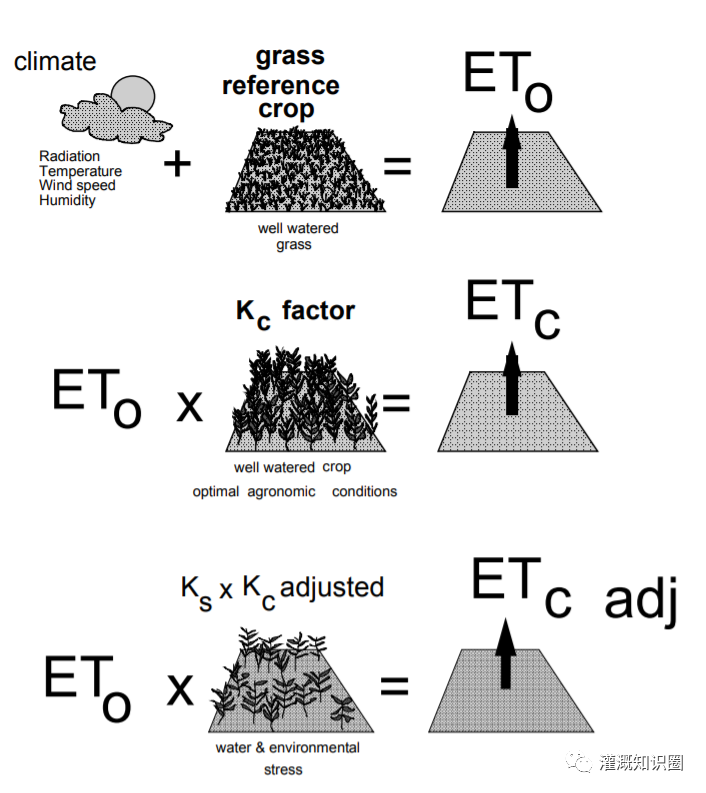
FIGURE 4
Reference (ETo), crop evapotranspiration under standard (ETc) and non-standard conditions (ETc adj)
图 4 参考 (ETo)、标准条件下的作物蒸散量 (ETc) 和非标准条件 (ETc adj)
当现场条件与标准条件不同时,需要校正因子来调整 ETc。调整反映了田间环境和管理条件对作物蒸散的影响。
EVAPOTRANSPIRATION CONCEPTS 蒸散量概念
参考作物蒸散量 (ETo)、标准条件下的作物蒸散量 (ETc) 和非标准条件下的作物蒸散量 (ETc adj) 之间存在区别(图 4)。ETo 是表示大气蒸发能力的气候参数。ETc 是指在给定的气候条件下,管理良好、大面积、水分充足的田地的蒸散量。由于存在影响作物生长和限制蒸散的因素,次优作物管理和环境限制,非标准条件下的 ETc 通常需要校正。
Reference crop evapotranspiration 参考作物蒸散量 (ETo)
来自不缺水的参考地表的蒸散率称为参考作物蒸散量或参考蒸散量,记为 ETo。参考表面是具有特定特征的假设草参考作物。由于定义不明确,强烈建议不要使用其它名称,例如潜在的 ET。
引入参考蒸发量的概念来研究与作物类型、作物发育和管理实践无关的大气蒸发需求。由于参考蒸散面的水量充足,因此土壤因素不会影响 ET。将 ET 与特定表面相关联提供了一个参考,来自其他表面的 ET 可以与之相关。它消除了为每种作物和生长阶段定义单独的 ET 水平的需要。在不同地点或不同季节测量或计算的 ETo 值具有可比性,因为它们指的是来自同一参考表面的 ET。
影响 ETo 的唯一因素是气候参数。因此,ETo 是一个只与气候相关的参数,可以从天气数据中计算出来。ETo 表示一年中特定地点和时间的大气蒸发能力,不考虑作物特征和土壤因素。推荐使用粮农组织 Penman-Monteith 方法作为确定 ETo 的唯一方法。选择该方法是因为它在评估的位置非常接近草类作物 ETo,基于物理,并且明确地结合了生理和空气动力学参数。此外,已经开发了用于估计缺失的气候参数的程序。
表 2 给出了不同农业气候区域的 ETo 值的典型范围。这些值可以让没有经验的用户熟悉典型范围,而不是直接应用。本手册的 A 部分讨论了参考作物蒸散量的计算(Box 1 插文 1)。
Crop evapotranspiration under standard conditions 标准条件下的作物蒸散量 (ETc)
标准条件下的作物蒸散量,记作ETc,是指无病害、施肥良好、在大田中生长、在最佳土壤水分条件下,并在给定气候条件下实现充分生产的作物的蒸散量。
TABLE 2 Average ETo for different agroclimatic regions in mm/day
表 2 不同农业气候区的平均 ETo(毫米/天)
Regions | Mean daily temperature (°C) | ||
Cool ~ 10°C | Moderate 20°C | Warm > 30°C | |
Tropics and subtropics - humid and sub-humid - arid and semi-arid | 2 - 3 2 - 4 | 3 - 5 4 - 6 | 5 - 7 6 - 8 |
Temperate region - humid and sub-humid - arid and semi-arid | 1 - 2 1 - 3 | 2 - 4 4 - 7 | 4 - 7 6 - 9 |
BOX 1 Chapters concerning the calculation of the reference crop evapotranspiration (ETo) PART A ----- Chapter 2 - FAO Penman-Monteith equation: This chapter introduces the user to the need to standardize one method to compute ETo from meteorological data. The FAO Penman-Monteith method is recommended as the method for determining reference ETo. The method and the corresponding definition of the reference surface are described. Chapter 3 - Meteorological data: The FAO Penman-Monteith method requires radiation, air temperature, air humidity and wind speed data. Calculation procedures to derive climatic parameters from the meteorological data are presented. Procedures to estimate missing meteorological variables required for calculating ETo are outlined. This allows for estimation of ETo with the FAO Penman-Monteith method under all circumstances, even in the case of missing climatic data. Chapter 4 - Determination of ETo: The calculation of ETo by means of the FAO Penman-Monteith equation, with different time steps, from the principal weather parameters and with missing data is described. The determination of ETo from pan evaporation is also presented. 有关计算参考作物蒸散量 (ETo) 的章节 第一部分 ----- 第 2 章 - 粮农组织 Penman-Monteith 方程: 本章向用户介绍了标准化一种从气象数据计算 ETo 的方法的必要性。推荐使用粮农组织 Penman-Monteith 方法作为确定参考 ETo 的方法。描述了参考面的方法和相应的定义。 第 3 章 - 气象数据: 粮农组织 Penman-Monteith 方法需要辐射、气温、空气湿度和风速数据。介绍了从气象数据中推导出气候参数的计算程序。概述了计算 ETo 所需的估计缺失气象变量的程序。这允许在所有情况下使用粮农组织 Penman-Monteith 方法估计 ETo,即使在缺少气候数据的情况下也是如此。 第 4 章 - ETo 的确定: 描述了通过粮农组织 Penman-Monteith 方程、不同时间步长、主要天气参数和缺失数据计算 ETo。还介绍了从锅蒸发中测定 ETo。 |
BOX 2 Chapters concerning the calculation of crop evapotranspiration under standard conditions (ETc) PART B ----- Chapter 5 - Introduction to crop evapotranspiration: This chapter introduces the user to the 'Kc ETo' approach for calculating crop evapotranspiration. The effects of characteristics that distinguish field crops from the reference grass crop are integrated into the crop coefficient Kc. Depending on the purpose of the calculation, the required accuracy, the available climatic data and the time step with which the calculations have to be executed, a distinction is made between two calculation methods. Chapter 6 - ETc - Single crop coefficient (Kc): This chapter presents the first calculation method for crop evapotranspiration whereby the difference in evapotranspiration between the cropped and reference grass surface is combined into a single crop coefficient (Kc). Chapter 7 - ETc - Dual crop coefficient (Kc = Kcb + Ke): This chapter presents the other calculation method for crop evapotranspiration. Kc is split into two separate coefficients, one for crop transpiration (i.e., the basal crop coefficient Kcb) and one for soil evaporation (Ke). 关于计算标准条件下作物蒸散量 (ETc) 的章节 B部分 ----- 第 5 章 - 作物蒸散简介: 本章向用户介绍了计算作物蒸散量的“Kc ETo”方法。将大田作物与参考草作物区分开来的特征的影响整合到作物系数 Kc 中。根据计算的目的、所需的精度、可用的气候数据和必须执行计算的时间步长,两种计算方法之间存在区别。 第 6 章 - ETc - 单作物系数 (Kc): 本章介绍了作物蒸散量的第一种计算方法,即 作物表面和参考草地表面之间的蒸散量合并为单一作物系数 (Kc)。 第 7 章 - ETc - 双作物系数 (Kc = Kcb + Ke): 本章介绍了作物蒸散量的另一种计算方法。Kc 分为两个独立的系数,一个用于作物蒸腾(即基础作物系数 Kcb),另一个用于土壤蒸发(Ke)。 |
补偿农田蒸散损失所需的水量定义为作物需水量。尽管作物蒸散量和作物需水量的值相同,但作物需水量是指需要供应的水量,而作物蒸散量是指通过蒸发量损失的水量。灌溉需水量基本上代表作物需水量与有效降水量之差。灌溉水需求还包括用于浸出洗盐和补偿水应用等非均匀性灌水的额外用水。本出版物不涉及灌溉用水需求的计算,但将成为未来灌溉和排水论文的主题。
作物蒸散量可以从气候数据中计算出来,并通过直接整合 Penman-Monteith 方法中的作物抗性、反照率和空气阻力因素来计算。由于不同作物的信息仍然相当缺乏,因此使用 Penman-Monteith 方法估计标准参考作物以确定其蒸散率,即 ETo。通过实验确定的 ETc/ETo 比率,称为作物系数 (Kc),用于将 ETc 与 ETo 或 ETc = Kc ETo 联系起来。
叶片解剖结构、气孔特征、空气动力学特性甚至反光照率的差异导致相同气候条件下作物蒸散量与参考作物蒸散量不同。由于整个生长季节作物特性的变化,给定作物的 Kc 从播种到收获会发生变化。本手册的 B 部分讨论了标准条件下作物蒸散量 (ETc) 的计算(Box 2 插文 2)。
Crop evapotranspiration under non-standard conditions 非标准条件下的作物蒸散量(ETc adj)
非标准条件下的作物蒸散量(ETc adj)是指在不同于标准条件的管理和环境条件下种植的作物的蒸散量。在田间种植作物时,由于存在病虫害、土壤盐分、土壤肥力低、缺水或内涝等非最佳条件,作物的实际蒸散量可能会偏离ETc。这可能导致植物生长不足,植物密度低,并可能降低作物的蒸散率,低于 ETc。
非标准条件下的作物蒸散量是通过使用水分胁迫系数 Ks 和/或针对作物蒸散的各种其他胁迫和环境限制调整 Kc 来计算的。本手册 C 部分讨论了针对水资源压力、管理和环境限制对 ETc 的调整(Box 3 插文 3)。
DETERMINING EVAPOTRANSPIRATION 确定蒸发量
ET measurement ET测量
蒸散量不容易测量。需要特定设备和准确测量各种物理参数或蒸渗仪中的土壤水分平衡来确定蒸散量。这些方法通常很昂贵,对测量的准确性要求很高,并且只能由训练有素的研究人员来正确操作使用。尽管这些方法不适用于常规测量,但它们对于评估通过更间接方法获得的 ET 估计值仍然很重要。
BOX 3 Chapters concerning the calculation of crop evapotranspiration under non-standard conditions (ETc adj) PART C ----- Chapter 8 - ETc under soil water stress conditions: This chapter discusses the reduction in transpiration induced by soil moisture stress or soil water salinity. The resulting evapotranspiration will deviate from the crop evapotranspiration under standard conditions. The evapotranspiration is computed by using a water stress coefficient, Ks, describing the effect of water stress on crop transpiration. Chapter 9 - ETc for natural, non-typical and non-pristine vegetation: Procedures that can be used to make adjustments to the Kc to account for less than perfect growing conditions or stand characteristics are discussed. The procedures can also be used to determine Kc for agricultural crops not listed in the tables of Part B. Chapter 10 - ETc under various management practices: This chapter discusses various types of management practices that may cause the values for Kc and ETc to deviate from the standard conditions described in Part B. Adjustment procedures for Kc to account for surface mulches, intercropping, small areas of vegetation and management induced stress are presented. Chapter 11 - ETc during non-growing periods: This chapter describes procedures for predicting ETc during non-growing periods under various types of surface conditions. 非标准条件下作物蒸散计算的章节(ETc adj) C部分 ----- 第 8 章 - 土壤水分胁迫条件下的 ETc: 本章讨论由土壤水分胁迫或土壤水分引起的蒸腾减少 盐度。产生的蒸散量将偏离标准条件下的作物蒸散量。蒸散量是通过使用水分胁迫系数 Ks 来计算的,Ks 描述了水分胁迫对作物蒸腾的影响。 第 9 章 - 自然、非典型和非原始植被的 ETc: 讨论了可用于调整 Kc 以解决不完美的生长条件或林木特征的程序。该程序还可用于确定 B 部分表格中未列出的农作物的 Kc。 第 10 章 - 各种管理实践下的 ETc: 本章讨论了可能导致 Kc 和 ETc 值偏离 B 部分中描述的标准条件的各种类型的管理实践。介绍了 Kc 的调整程序,以考虑地表覆盖物、间作、小面积植被和管理引起的压力. 第 11 章 - 非生长期的 ETc: 本章描述了在各种地表条件下预测非生长期 ETc 的程序。 |
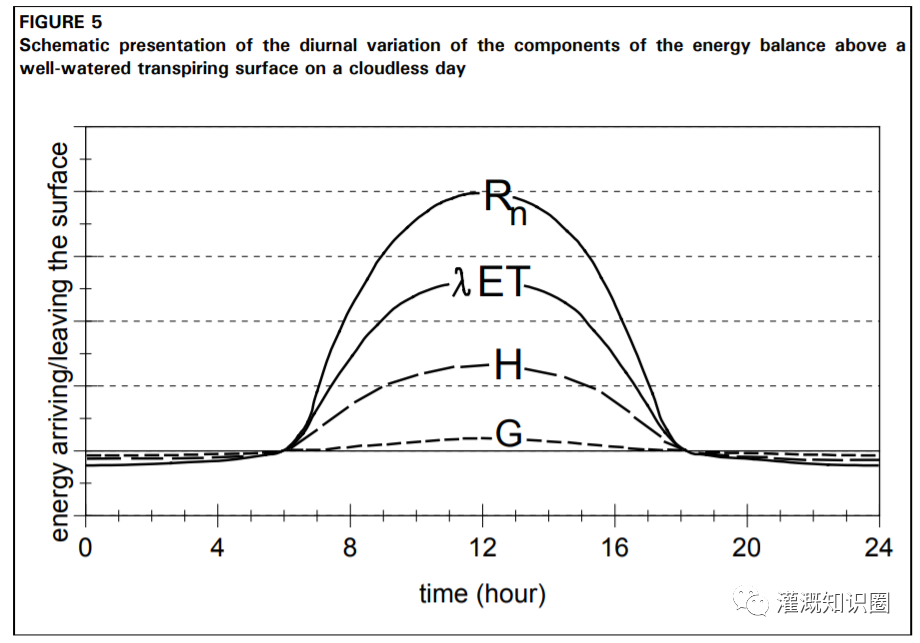
图 5 无云日水分充足的蒸腾面上方能量平衡成分的日变化示意图
Energy balance and microclimatological methods 能量平衡和小气候方法
水的蒸发需要相对大量的能量,无论是显热还是辐射能。因此,蒸散过程受植被表面的能量交换控制,并受到可用能量的限制。由于这个限制,可以通过应用能量守恒原理来预测蒸散率。到达地表的能量必须等于在同一时间段内离开地表的能量。
在推导能量平衡方程时,应考虑所有能量通量。
蒸发面的方程可以写成:
Rn - G - lET - H = 0 (1)
其中 Rn 是净辐射,H 是显热,G 是土壤热通量,lET 是潜热通量。各种术语可以是正面的也可以是负面的。正 Rn 向表面提供能量,正 G、lET 和 H 从表面移除能量(图 5)。
在等式 1 中,仅考虑垂直通量,而忽略了能量通过平流水平传输的净速率。因此,该等式仅适用于均质植被的大而广泛的表面。该方程仅限于四个分量:Rn、lET、H 和 G。不考虑其他能量项,例如植物中储存或释放的热量,或用于代谢活动的能量。这些项仅占一小部分每日净辐射的一小部分,与其他四个组成部分相比可以忽略不计。
如果所有其他分量都已知,则表示蒸散分数的潜热通量(lET)可以从能量平衡方程中推导出来。净辐射 (Rn) 和土壤热通量 (G) 可以从气候参数中测量或估计。然而,显热 (H) 的测量很复杂并且不容易获得。H 需要准确测量表面以上的温度梯度。
另一种估算蒸发量的方法是传质法。这种方法考虑了小块空气(涡流)在大的均匀表面上方的垂直运动。涡流将物质(水蒸气)和能量(热量、动量)从朝向蒸发表面传输。通过假设稳态条件并且水蒸气的涡流传递系数与热量和动量的涡流传递系数成正比,可以通过鲍文比从空气温度和水蒸气的垂直梯度计算蒸散速率。其他直接测量方法使用风速和水蒸气的梯度。这些方法和其他方法(如涡流协方差)需要准确测量地表以上不同高度的蒸汽压力、气温或风速。因此,它们的应用仅限于主要研究情况。
Soil water balance 土壤水分平衡
蒸散也可以通过测量土壤水分平衡的各种成分来确定。该方法包括评估一段时间内进入和流出作物根区的水通量(图 6)。灌溉 (I) 和降雨 (P) 将水添加到根区。部分 I 和 P 可能会因地表径流 (RO) 和深层渗流而损失(DP),最终将补充为地下水位。水也可能通过毛细上升(CR)从浅水位向上输送到根区,甚至通过地下流进入(SFin)或流出(SFout)根区水平输送。然而,在许多情况下,除了在斜率较大的情况下,SFin 和 SFout 都很小,可以忽略不计。土壤蒸发和作物蒸腾消耗了根区的水分。如果可以评估除蒸散 (ET) 以外的所有通量,则可以从土壤含水量 (DSW) 在一段时间内的变化中推断出蒸散:
ET = I + P - RO - DP + CR ± DSF ± DSW (2)
一些通量,例如地下流动、深层渗流和地下水位的毛细上升,很难评估,不能考虑短时间。土壤水平衡法通常只能给出一周或十天左右的长时间内的 ET 估计值。
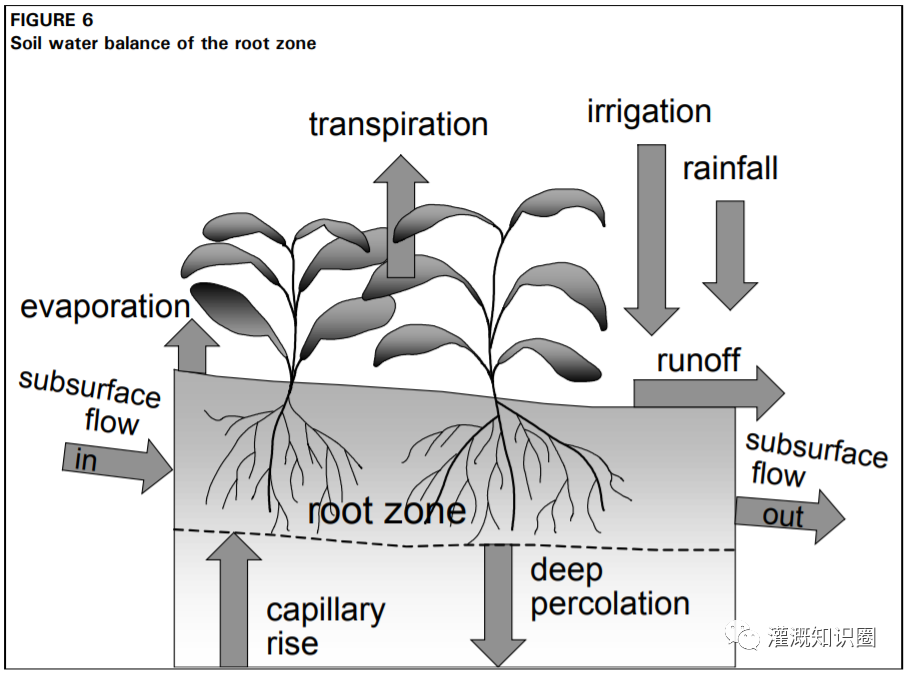
图 6 根区土壤水分平衡
Lysimeters 蒸渗仪
通过将作物根区与其环境隔离并控制难以测量的过程,可以更准确地确定土壤水分平衡方程中的不同项。这是在蒸渗仪中完成的,作物生长在受干扰或未受干扰土壤的隔离罐中。在精密称重蒸渗仪中,直接通过质量变化来测量失水量,可以得到精确到百分之几毫米的蒸散量,并且可以得到一个小时的等小时间段。
经过考虑的。在非称重蒸渗仪中,给定时间段的蒸散量是通过从总水输入中减去在蒸渗仪底部收集的排水水来确定的。
蒸渗仪的要求是蒸渗仪内部和邻近的、外部的植被必须完美匹配(相同的高度和叶面积指数)。历史上,大多数蒸渗仪研究并未严格遵守这一要求,并导致严重错误和得出不具代表性的 ETc 和 Kc 数据。
由于蒸渗仪的建造困难且昂贵,而且它们的操作和维护需要特别小心,因此它们仅限于用在特定的研究目的。
ET computed from meteorological data 从气象数据计算的 ET
由于难以获得准确的现场测量结果,ET 通常由天气数据计算得出。已经开发了大量经验或半经验方程,用于根据气象数据评估作物或参考作物蒸散量。有些方法仅在特定的气候和农艺条件下才有效,不能在与最初开发时不同的条件下应用。
许多研究人员分析了不同位置的各种计算方法的性能。作为 1990 年 5 月举行的专家磋商会的结果,现在建议将粮农组织 Penman-Monteith 方法作为定义和计算参考蒸散量 ETo 的标准方法。标准条件下作物表面的 ET 由将 ETc 与 ETo 相关的作物系数 (Kc) 确定。非标准条件下作物表面的 ET 通过水分胁迫系数 (Ks) 和/或通过修改作物系数来调整。
ET estimated from pan evaporation 从蒸发皿蒸发估计的 ET
开阔水面的蒸发量提供了辐射、气温、空气湿度和风对蒸发量的综合影响的指标。然而,水和农作物表面的差异会导致开阔水面和农作物的水分流失存在显著差异。该蒸发皿已证明其实用的价值,并已成功用于通过观察皿的水面蒸发损失并应用经验系数将皿盘水面蒸发与 ETo 联系起来,来估计参考蒸发量。该过程在第 3 章中进行了概述。
Part A 部分
Reference evapotranspiration 参考蒸散量 (ETo)
A 部分处理来自参考表面的蒸散,即所谓的参考作物蒸散或参考蒸散,表示为 ET。参考作物的耗水面是:
假设作物高度为 0.12 m 的,假定草参考作物,固定表面阻力为,70 s m-1 和 0.23 的反照率。参考表面非常类似于绿色的广泛表面,高度均匀的浇水良好的草,积极生长并完全遮蔽地面。70 s m-1 的固定表面阻力意味着由大约每周灌溉频率产生的适度干燥的土壤表面。
ET 可以从气象数据中计算出来。由于在1990 年 5 月,FAO Penman-Monteith 方法现在被推荐为定义和计算参考蒸散量的唯一标准方法。粮农组织 Penman-Monteith 方法需要辐射、气温、空气湿度和风速数据。从气象数据中推导出气候参数和估计缺失气象数据的计算程序本部分(第 3 章)介绍了计算 ET 所需的变量。本出版物中的程序计算允许使用粮农组织 Penman-Monteith 方法估算 ET,在任何情况下,即使是在缺少气候数据的情况下。
ET 也可以从蒸发皿蒸发来估计。蒸发皿已经证明了它们的实用价值和已成功用于通过观察锅中的水分流失来估计 ET,并使用将蒸发皿蒸发与 ET 联系起来的经验系数。但是,特殊的预防措施和必须进行的管理。







